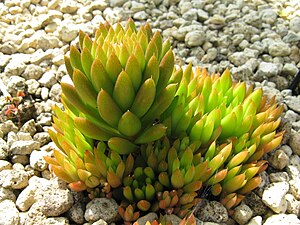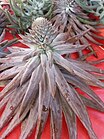Note: This is a project under development. The articles on this wiki are just being initiated and broadly incomplete. You can Help creating new pages.
Difference between revisions of "Orostachys japonica - Rock pine"
(→Identification) |
|||
| (11 intermediate revisions by 2 users not shown) | |||
| Line 1: | Line 1: | ||
[[File:Orostachys japonicus1.jpg|thumb|right|''Rock pine'', ''Orostachys japonica'']] | [[File:Orostachys japonicus1.jpg|thumb|right|''Rock pine'', ''Orostachys japonica'']] | ||
| − | + | '''Rock pine''' is a species of flowering plant in the genus Orostachys. Native to Japan. Its main habitat is on the surface of mountain rocks in Korea and Japan and rocks on low mountains along streams in China. | |
| − | '''Rock pine''' is a species of flowering plant in the genus Orostachys. Native to Japan. Its main habitat is on the surface of mountain rocks in Korea and Japan | ||
| − | |||
==Uses== | ==Uses== | ||
| − | {{Uses| | + | {{Uses|Cancer}}, {{Uses|Gingivitis}}, {{Uses|Metritis}}, {{Uses|Liver disorders}}, {{Uses|Skin eruptions}}, {{Uses|Blotches}}, {{Uses|Pimples}}, {{Uses|Diarrhea}}, {{Uses|Sore throats}} |
==Parts Used== | ==Parts Used== | ||
| − | {{Parts Used|Leaves}}, {{Parts Used| | + | {{Parts Used|Leaves}}, {{Parts Used|Flowers}}. |
==Chemical Composition== | ==Chemical Composition== | ||
| − | The leaves and stems contain several medically active constituents including fatty acid esters and flavonoids<ref name="chemical composition"/> | + | The leaves and stems contain several medically active constituents including fatty acid esters and flavonoids.<ref name="chemical composition"/> |
==Common names== | ==Common names== | ||
| − | {{Common names|kn=|ml=|sa=|ta=|te=|hi=|en= | + | {{Common names|kn=|ml=|sa=|ta=|te=|hi=|en=Rock pine}} |
==Properties== | ==Properties== | ||
| Line 36: | Line 34: | ||
==Identification== | ==Identification== | ||
===Leaf=== | ===Leaf=== | ||
| − | {{Leaf|Simple|| | + | {{Leaf|Simple||These herbs with leaves in dense rosettes which will elongate}}<ref name="Leaf"/> |
===Flower=== | ===Flower=== | ||
| − | {{Flower|Unisexual|2-4cm long| | + | {{Flower|Unisexual|2-4cm long|White|5|When the flowers bloom and produce seeds, the rosette dries out}} |
===Fruit=== | ===Fruit=== | ||
| − | {{Fruit|Erect|| | + | {{Fruit|Erect||Clearly grooved lengthwise, Lowest hooked hairs aligned towards crown||Many}} |
===Other features=== | ===Other features=== | ||
==List of Ayurvedic medicine in which the herb is used== | ==List of Ayurvedic medicine in which the herb is used== | ||
| − | |||
==Where to get the saplings== | ==Where to get the saplings== | ||
| Line 54: | Line 51: | ||
==How to plant/cultivate== | ==How to plant/cultivate== | ||
| − | We have very little information on this species and do not know if it will be hardy in Britain. However, judging by its native range, it is likely to succeed outdoors in most areas of the country<ref name="How to plant/cultivate"/> | + | We have very little information on this species and do not know if it will be hardy in Britain. However, judging by its native range, it is likely to succeed outdoors in most areas of the country.<ref name="How to plant/cultivate"/> |
==Commonly seen growing in areas== | ==Commonly seen growing in areas== | ||
| − | {{Commonly seen|Surface of mountain rocks}}, {{Commonly seen|Rocks on low mountains}}, {{Commonly seen| | + | {{Commonly seen|Surface of mountain rocks}}, {{Commonly seen|Rocks on low mountains}}, {{Commonly seen|Along streams}}. |
==Photo Gallery== | ==Photo Gallery== | ||
<gallery class="left" caption="" widths="140px" heights="140px"> | <gallery class="left" caption="" widths="140px" heights="140px"> | ||
| − | + | Mägitähk, rock pine, Orostachys japonica.jpg | |
| + | Orostachys Japonica 1.jpg | ||
| + | Orostachys Japonica 2.jpg | ||
| + | Orostachys Japonica 3.jpg | ||
</gallery> | </gallery> | ||
| Line 67: | Line 67: | ||
<references> | <references> | ||
| − | <ref name="chemical composition">[http://www.naturalmedicinalherbs.net/herbs/o/orostachys-japonica=rock-pine.php | + | <ref name="chemical composition">[http://www.naturalmedicinalherbs.net/herbs/o/orostachys-japonica=rock-pine.php Chemical constituents]</ref> |
| − | <ref name="Leaf">[ | + | <ref name="Leaf">[http://www.llifle.com/Encyclopedia/SUCCULENTS/Family/Crassulaceae/30876/Orostachys_japonica Plant description]</ref> |
| − | <ref name="How to plant/cultivate">[https://www.pfaf.org/user/Plant.aspx?LatinName=Orostachys+japonica | + | <ref name="How to plant/cultivate">[https://www.pfaf.org/user/Plant.aspx?LatinName=Orostachys+japonica Cultivation details]</ref> |
</references> | </references> | ||
| Line 80: | Line 80: | ||
[[Category:Herbs]] | [[Category:Herbs]] | ||
| + | [[Category:Crassulaceae]] | ||
Latest revision as of 15:10, 10 June 2020
Rock pine is a species of flowering plant in the genus Orostachys. Native to Japan. Its main habitat is on the surface of mountain rocks in Korea and Japan and rocks on low mountains along streams in China.
Contents
- 1 Uses
- 2 Parts Used
- 3 Chemical Composition
- 4 Common names
- 5 Properties
- 6 Habit
- 7 Identification
- 8 List of Ayurvedic medicine in which the herb is used
- 9 Where to get the saplings
- 10 Mode of Propagation
- 11 How to plant/cultivate
- 12 Commonly seen growing in areas
- 13 Photo Gallery
- 14 References
- 15 External Links
Uses
Cancer, Gingivitis, Metritis, Liver disorders, Skin eruptions, Blotches, Pimples, Diarrhea, Sore throats
Parts Used
Chemical Composition
The leaves and stems contain several medically active constituents including fatty acid esters and flavonoids.[1]
Common names
| Language | Common name |
|---|---|
| Kannada | |
| Hindi | |
| Malayalam | |
| Tamil | |
| Telugu | |
| Marathi | NA |
| Gujarathi | NA |
| Punjabi | NA |
| Kashmiri | NA |
| Sanskrit | |
| English | Rock pine |
Properties
Reference: Dravya - Substance, Rasa - Taste, Guna - Qualities, Veerya - Potency, Vipaka - Post-digesion effect, Karma - Pharmacological activity, Prabhava - Therepeutics.
Dravya
Rasa
Tikta (Bitter), Kashaya (Astringent)
Guna
Laghu (Light), Ruksha (Dry), Tikshna (Sharp)
Veerya
Ushna (Hot)
Vipaka
Katu (Pungent)
Karma
Kapha, Vata
Prabhava
Habit
Identification
Leaf
| Kind | Shape | Feature |
|---|---|---|
| Simple | These herbs with leaves in dense rosettes which will elongate |
Flower
| Type | Size | Color and composition | Stamen | More information |
|---|---|---|---|---|
| Unisexual | 2-4cm long | White | 5 | When the flowers bloom and produce seeds, the rosette dries out |
Fruit
| Type | Size | Mass | Appearance | Seeds | More information |
|---|---|---|---|---|---|
| Erect | Clearly grooved lengthwise, Lowest hooked hairs aligned towards crown | Many | {{{6}}} |
Other features
List of Ayurvedic medicine in which the herb is used
Where to get the saplings
Mode of Propagation
How to plant/cultivate
We have very little information on this species and do not know if it will be hardy in Britain. However, judging by its native range, it is likely to succeed outdoors in most areas of the country.[3]
Commonly seen growing in areas
Surface of mountain rocks, Rocks on low mountains, Along streams.
Photo Gallery
References
External Links
- Ayurvedic Herbs known to be helpful to treat Cancer
- Ayurvedic Herbs known to be helpful to treat Gingivitis
- Ayurvedic Herbs known to be helpful to treat Metritis
- Ayurvedic Herbs known to be helpful to treat Liver disorders
- Ayurvedic Herbs known to be helpful to treat Skin eruptions
- Ayurvedic Herbs known to be helpful to treat Blotches
- Ayurvedic Herbs known to be helpful to treat Pimples
- Ayurvedic Herbs known to be helpful to treat Diarrhea
- Ayurvedic Herbs known to be helpful to treat Sore throats
- Herbs with Leaves used in medicine
- Herbs with Flowers used in medicine
- Herbs with common name in English
- Habit - Perennial plant
- Index of Plants which can be propagated by Seeds
- Index of Plants which can be propagated by Cuttings
- Herbs that are commonly seen in the region of Surface of mountain rocks
- Herbs that are commonly seen in the region of Rocks on low mountains
- Herbs that are commonly seen in the region of Along streams
- Herbs
- Crassulaceae




